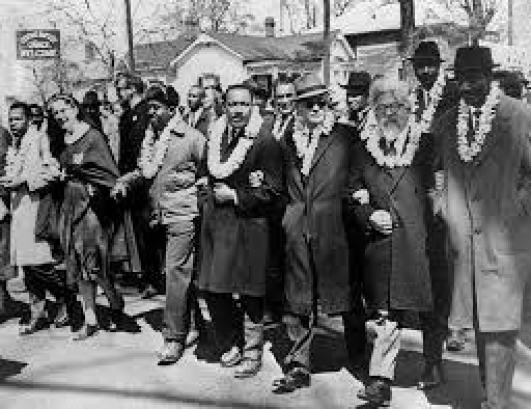On Tuesday, five of us[1] flew to South Carolina to march in the NAACP’s Journey for Justice.[2]
Why? This poem from American poet Langston Hughes (1902-1967):
“Let America be America again.
Let it be the dream it used to be.
Let it be the pioneer on the plain
Seeking a home where he himself is free.
(America never was America to me)…”
We began. Passing the Columbia State House, we noted the poignant absence of the Confederate flag, finally removed following the tragic, racist church shootings in June.
At the front of our column, an American flag was carried high by a black veteran of Korea and Vietnam. He drew his name, Middle Passage, from a slave forebear.
“Let America be the dream the dreamers dreamed-
Let it be that great strong land of love
Where never kings connive nor tyrants scheme
That any man be crushed by one above.
(It never was America to me.)…”
Each block, passing stores and restaurants, folks came out to cheer. Cars honked, passengers waved support. We marched through middle class and lower middle class neighborhoods – and people noticed. They came out for hope. We were a bit of evidence that black lives matter. And not only to blacks.
“I am the poor white, fooled and pushed apart,
I am the Negro bearing slavery’s scars.
I am the red man driven from the land,
I am the immigrant clutching the hope I seek-
And finding only the same old stupid plan
Of dog eat dog, of mighty crush the weak…
I am the people, humble, hungry, mean-
Hungry yet today despite the dream…”
We weren’t a large group.[3] And there wasn’t much publicity, in local or national news. What was the value in our participation?
We Barnert folks celebrated our own Rabbi Martin Freedman z”l, a Freedom Rider in Tallahassee, FL.[4] This was our chance to “walk the talk.”
Times have changed. But not enough. I walked alongside an Episcopal priest. She was white, her husband was black, and their bi-racial children suffered terrible discrimination. Her 14 year old son had been arrested by police in Edison, NJ on charges of assault.[5] But there had been no assault. Her son, walking in their white neighborhood, was stopped by police; when he answered a question with a smart-mouthed teen response, they handcuffed him.
This mother was drawn to a ministry with black prisoners, guiding them to manage anger and resentment, to forgive and then shape new lives.[6]
We marched with Keshia Thomas, a black woman devoted to spreading the message among frustrated teens that violence is wrong, period. Her story: in 1996, the KKK tried to organize a rally in Ann Arbor, MI. Hundreds of people gathered to protest. A rumor spread that someone was a Klansman, and people began to mob him. Keshia leapt forward and spread herself over the man, protecting him. A photographer from LIFE captured the moment, and Keshia gained a name for peaceful resistance. Her message has influenced thousands. Most recently she met young people in Baltimore after the death of Freddy Grey and the subsequent torching of a CVS store. “Look across the street,” she said to them. “There’s a Senior Home. What do you think those folks are thinking and feeling about you? Would you want to be in that home, and not feel safe going out on your street? Find another way to protest. Advocate peacefully with me!”
Alongside the American flag, we carried a Torah. Each night it was passed to the next day’s Jewish marchers. Torah: symbol of just civilization. Torah: witness to our own brand of persecution. We get it. So we speak out.
“…For I’m the one who left dark Ireland’s shore,
And Poland’s plain, and England’s grassy lea,
And torn from Black Africa’s strand I came
To build a ‘homeland of the free.’ …”
Civil rights earned can be lost. Racism is real. Criminal injustice is real. The challenge to the Voting Rights Act is real. The cycle of Poverty is real.
Returning at the end of the day, we unwrapped the Torah around us, and shared our reactions. We recalled the Jewish Journey, fleeing slavery, seeking freedom.
“Standing on the parted shores, we still believe what we were taught before ever we stood at Sinai’s foot; that wherever we go, it is eternally Egypt; that there is a better place, a promised land; that the winding way to that promise passes through the wilderness. That there is no way to get from here to there except by joining hands, marching together.”[7]
There’s a lot more to be done in our nation. Let’s do it together.
—
Rabbi Elyse Frishman serves Barnert Temple in Franklin Lakes, NJ and is the editor of Mishkan T’filah.
[1] The Barnert team: Lisa Dugal, Marni Neuburger, Isaac Hart (a sophomore at Glen Rock High School) and Anya Gips (senior at Fairlawn High School and BarTY President) and me. Read Anya’s and Isaac’s pieces separately!
[2] August 1-September 16, from Selma to Washington, hundreds of Americans are walking in solidarity for black civil rights.
[3] In fact, the greatest number of participants over the last 25 days has been Reform Jews.
[4] Our journey was much safer than his – we had the protection of state troopers.
[5] Her story echoes others I’ve heard of young black teens walking the streets in white north-western Bergen.
[6] She said to me, “Forget prison reform. It’ll never happen. After decades in my ministry, I’ve learned to devote all my energy to the victims, helping them move beyond their radically unfair pasts.”
[7] by Michael Walzer, adapted from Exodus, as found in Mishkan T’filah














